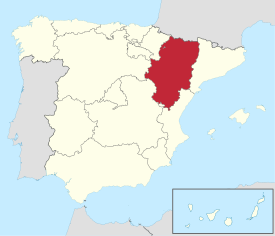
Back Aragonien ALS አራጎን Amharic Aragón AN منطقة أرغون Arabic اراجون ARZ Aragón AST Araqon Azerbaijani آراقون AZB Aragon BAN Aragon BCL
Aragon
| |
|---|---|
| Anthem: Himno de Aragón (officially) | |
 Location of Aragon within Spain | |
| Coordinates: 41°00′N 1°00′W / 41.000°N 1.000°W | |
| Country | Spain |
| Capital | Zaragoza |
| Provinces | Huesca, Teruel, and Zaragoza |
| Government | |
| • President | Jorge Azcón (PP) |
| • Legislature | Cortes of Aragon |
| Area (9.4% of Spain; ranked 4th) | |
• Total | 47,720 km2 (18,420 sq mi) |
| Population (1 January 2021) | |
• Total | 1,326,261 |
| • Density | 28/km2 (72/sq mi) |
| • Pop. rank | 11th |
| • Percent | 2.82% of Spain |
| Demonym | Aragonese |
| GDP | |
| • Total | €41.762 billion (2022) |
| • Per capita | €31,051 (2022) |
| ISO 3166 code | ES-AR |
| Official languages | Spanish |
| Recognised languages | Aragonese • Catalan[2] |
| Statute of Autonomy | 16 August 1982 18 April 2007 (current version) |
| National day | 23 April |
| Parliament | Cortes of Aragon |
| Congress seats | 13 (of 350) |
| Senate seats | 14 (of 265) |
| HDI (2021) | 0.912[3] very high · 5th |
| Website | Gobierno de Aragón |
 | |
Aragon (/ˈærəɡən/ ARR-ə-gən, US also /-ɡɒn, -ɡoʊn/ -gon, -gohn;[4] Spanish and Aragonese: Aragón [aɾaˈɣon] ; Catalan: Aragó [əɾəˈɣo]) is an autonomous community in Spain, coextensive with the medieval Kingdom of Aragon. In northeastern Spain, the Aragonese autonomous community comprises three provinces (from north to south): Huesca, Zaragoza, and Teruel. Its capital is Zaragoza. The current Statute of Autonomy declares Aragon a historic nationality of Spain.
Covering an area of 47720 km2 (18420 sq mi),[5] the region's terrain ranges diversely from permanent glaciers to verdant valleys, rich pasture lands and orchards, through to the arid steppes of the central lowlands. Aragon is home to many rivers—most notably, the river Ebro, Spain's largest river in volume, which runs west–east across the entire region through the province of Zaragoza. It is also home to the highest mountains of the Pyrenees.
As of January 2021[update], the population of Aragon was 1326261,[6] with slightly over half living in the capital city, Zaragoza. In 2020, the economy of Aragon generated a GDP of €34687 million, which represents 3.1% of Spain's national GDP,[7] and is currently 6th in per capita production behind Madrid, Basque Country, Navarre, Catalonia and La Rioja.[8]
In addition to its three provinces, Aragon is subdivided into 33 comarcas or counties. All comarcas of Aragon have a rich geopolitical and cultural history from its pre-Roman, Celtic and Roman days, four centuries of Islamic rule as Marca Superior of Al-Andalus or kingdom (or taifa) of Saraqusta, as lands that once belonged to the Frankish Marca Hispanica, counties that later formed the Kingdom of Aragon, and eventually the Crown of Aragon.
- ^ "Contabilidad Regional de España" (PDF). www.ine.es.
- ^ "LEY 10/2009, de 22 de diciembre, de uso, protección y promoción de las lenguas propias de Aragón" (PDF). Archived from the original on 28 March 2010. Retrieved 2010-04-29.
- ^ "Sub-national HDI - Area Database - Global Data Lab". hdi.globaldatalab.org. Retrieved June 24, 2023.
- ^ "Definition of ARAGON". www.merriam-webster.com. Retrieved 2023-01-21.
- ^ "Aragon Basic Data, 2017" (PDF). aragon.es. Archived from the original (PDF) on 2018-03-17. Retrieved 2018-03-18.
- ^ "Official Population Figures referring to revision of Municipal Register 1 January". Spanish Statistical Office. Instituto Nacional de Estadística. 1 January 2021. Retrieved 2 June 2022.
- ^ jiriarte (2010-07-16). "Aragon". ec.europa.eu. Retrieved 2018-03-17.
- ^ "PIB de las Comunidades Autónomas" [GDP of the Autonomous Communities]. datosmacro.com (in Spanish). Retrieved 30 December 2015.

